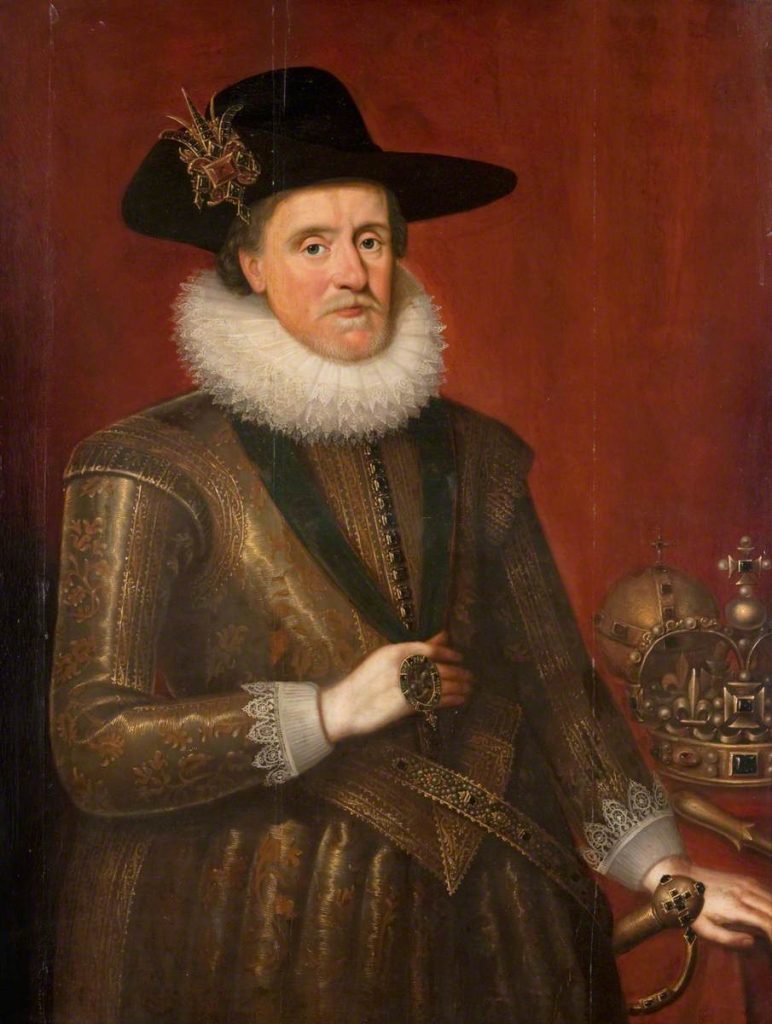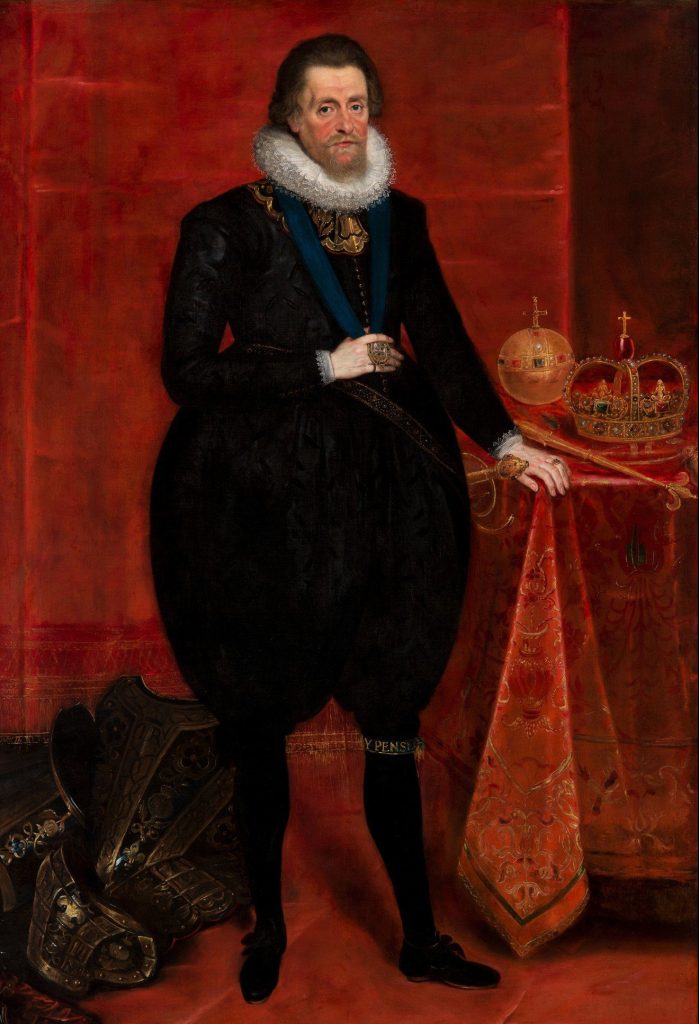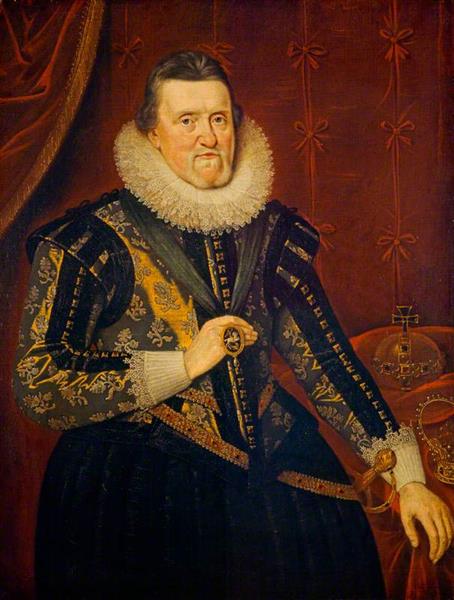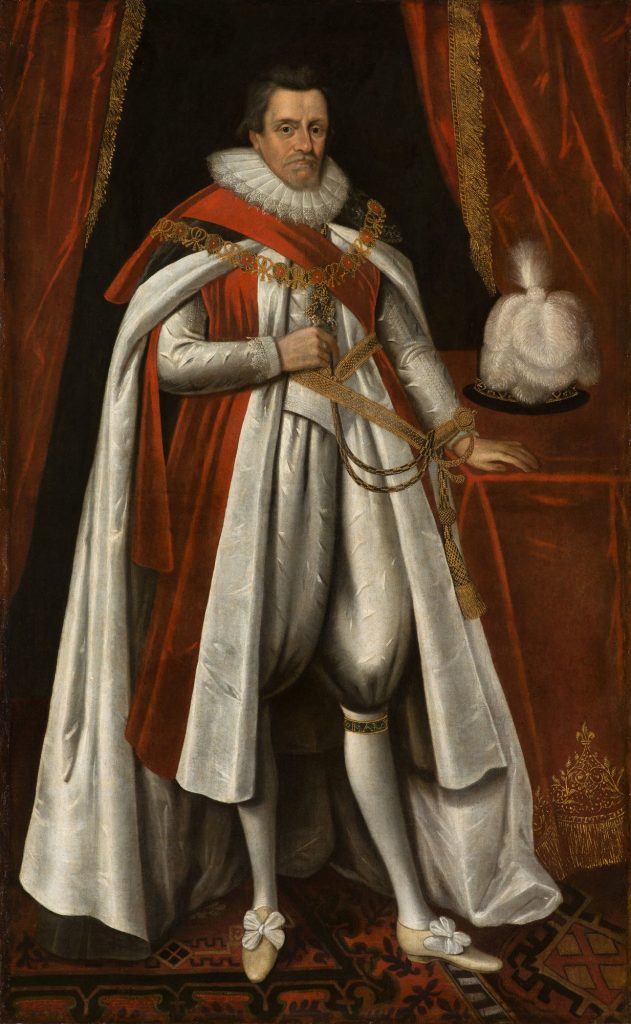By Rachael Gabriel | 9 March 2023

Life and Rule of James
Born on the 19 of June in 1566, James was the only offspring of the ill-fated union between Mary, Queen of Scots, and her second husband Henry, Lord Darnley. James was King of Scotland from 1567, ascending to the throne following the forced abdication of his mother. He became King of England and Ireland following the death of Queen Elizabeth I in 1603, uniting the independent countries and ruling them with varying degrees of success until his death in 1625. His marriage to Anne of Denmark was fruitful, lasting from 1589 to her death in 1619 and producing seven children, though only three survived infancy. [1]
Throughout history, James has been largely overshadowed by his more famous relatives, though recently more scholarly attention has been paid to his reign, role in uniting the kingdoms of Scotland and England, and his queer relationships with male courtiers. [2] Why is he important to the College? In 1599 he issued a Royal Charter, granting Peter Lowe, Robert Hamilton, William Spang, and their successors the power to establish the body which is known today as the Royal College of Physicians and Surgeons of Glasgow. James’ portrait, along with the portraits of Lowe, Hamilton and Spang, hangs in College Hall.


When | Who | How
Although the exact date of this portrait is unknown, it was most likely painted after James ascended to the English throne in 1603, as he can be seen wearing the Lesser George of the Garter around his neck. The Lesser George of the Garter was developed from the Most Noble Order of the Garter, a chivalric order established by Edward III in c. 1348 dedicated to the image and arms of St George. The Lesser George is ‘an image of St George encircled with the Garter worn as a separate badge. Lesser Georges were originally hung from a blue ribbon around the neck so as to be worn upon the breast.’ [3] James would most likely not have been granted entry to this Order before his ascension to the English throne.
A portrait of King James by Adam de Colone dated to around 1622 and a portrait by van Somer dated to around 1618 potentially pushes the date of this portrait back further – the similarities in poses, facial hair, costuming, and composition are evident. It is equally possible, as James disliked sitting for portraits, that one of these paintings was used as a reference for the commission of the others. [4]
If the date is thusly pushed back, it becomes even more difficult to confidently attribute the painting to an artist. Although the later date may signal the portrait belongs to the Circle of Daniel Mytens – as he became the favourite court painter after 1620 – other works attributed to the Circle of Paul van Somer more closely stylistically and visually align with this portrait. Even then, it is a tenuous venture to base attribution and date on chronological court favourites. It is decidedly safer and easier to conclude it is currently impossible to know.
Regardless, both Mytens and van Somer hailed from the Netherlands, bringing the aesthetics and ideas of the Northern Baroque, including rich brushwork and compositional grandeur, to their portraiture in England.


Analysis of the Painting – ‘Make sure to get my good side’
His crown just behind him on the table, his bejewelled sword peeking out by his hip, a large white ruff, and a black cavalier hat all contribute to emphasizing James’ import, status, and wealth. Pinned to his hat is an ornate pin heavy with jewels – a popular accessory James wore in many of his portraits. His globe, sphere and crown are prominently displayed, an obvious reference to James’ belief in the absolute divine right of kings and a motif that can be seen in many of his portraits.
By the early 1620s, James was in his mid-fifties, his hair was turning white, and his heavy drinking had left him with a ruddy tint to his cheeks – a physicality certainly seen in this portrait and others from around the same time. [5] Yet, we do not know to what extent this portrait literally painted over the more unfortunate aspects of his appearance. James is made to look beautiful and proud – in his features as well as his clothing – his piercing blue gaze is directed out towards his audience and subjects, his hat is carefully balanced, his complexion relatively clear, his luxurious suit intricately decorated. Many rulers commissioned work to show them in the peak physical form, even if they were suffering from illness or were not considered particularly attractive. James’ relative King Henry VIII was noted for his stylized and complimentary portraits. How does James want to be perceived as a monarch and a man in this portrait?
His doublet and truck hose are made of expensive silk fabric possibly embroidered with gold thread. We also can see what James’ full regal costume may have looked based on the portrait by Paul van Somer (dated 1618), as seen above. Clothing was ‘one of several ways by which a man could assert his position within this hierarchy…it was a powerful tool, when used correctly, as it was an integral part of a wider social and political vocabulary.’ [6] James not only wanted his portraiture to reflect his kingly nature and divine right to rule but also to emphasize the strength of the newly united England, Scotland, and Ireland under his hand. He used art to flex his status and wealth. [7]
Notice how in portraits of James’ contemporaries, notably Lowe, Hamilton, and Spang, they wear a more reserved (but still expensive) black suit – no need for austerity when one is king.
It is important to note that the painting of Lowe is a reproduction from 1822, the reproduction was restored in the early 1950s, and the original does not exist anymore (as far as we know). Consequently, no art historian worth their salt would make any definite claims in regards to an analysis of this painting. The new artist and restorer may have made changes when commissioned to repaint this portrait – and even if they made no visible changes, a new hand changes the painting regardless.
Rachael Gabriel is a postgrad student in the History of Art at the University of Glasgow. She completed this blog post as part of her work placement with the College.
References and Images
[1] The Royal Household. ‘James VI and I (r. 1567-1625)’. Accessed 7 March 2023. https://www.royal.uk/james-vi-and-i-r-1567-1625.
[2] National Portrait Gallery. ‘King James I of England and VI of Scotland’. Accessed 2 March 2023. www.npg.org.uk/collections/search/person/mp02390/king-james-i-of-england-and-vi-of-scotland.
[3] Field, Gemma. ‘A Royal Tradition: The History of the Order of Garter.’ Sotheby’s. 20 June 2018. https://www.sothebys.com/en/articles/a-royal-tradition-the-history-of-the-order-of-the-garter.
[4] Royal Collection Trust. ‘James VI and I (1566-1625)’. Accessed 2 March 2023. https://www.rct.uk/collection/401224/james-vi-i-1566-1625.
[5] Bellany, Alastair and Thokas Cogswell. The Murder of King James. New Haven and London: Yale University Press, 2015.
[6] Dean, Lucinda. ‘‘Richesse in Fassone and in Fairness’: Marriage, Manhood and Sartorial Splendour for Sixteenth-century Scottish Kings.’ The Scottish Historical Review 100, no. 3 (December 2021): 378-96.
National Galleries Scotland. ‘Adam de Colone’. Accessed 28 February 2023. https://www.nationalgalleries.org/art-and-artists/artists/adam-de-colone.
National Museums Scotland. ‘James VI and I.’ Accessed 7 March 2023. https://www.nms.ac.uk/explore-our-collections/stories/scottish-history-and-archaeology/james-vi-and-i/.


Leave a Reply
You must be logged in to post a comment.